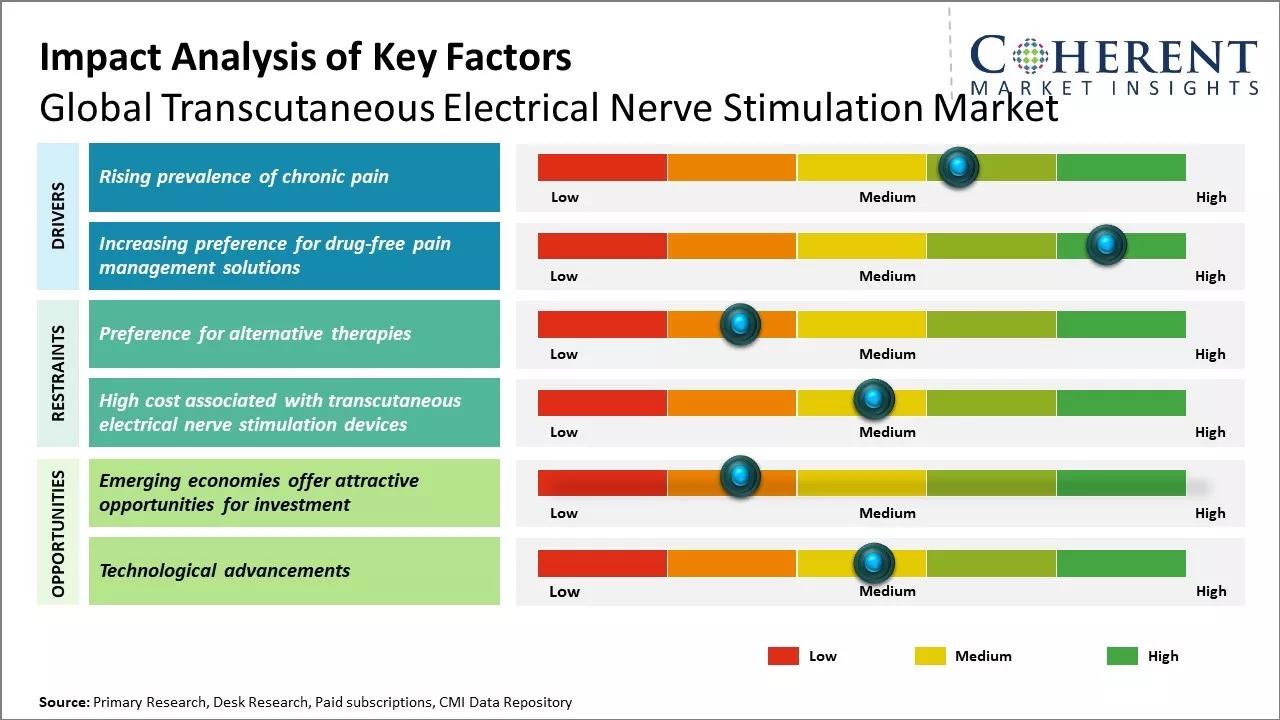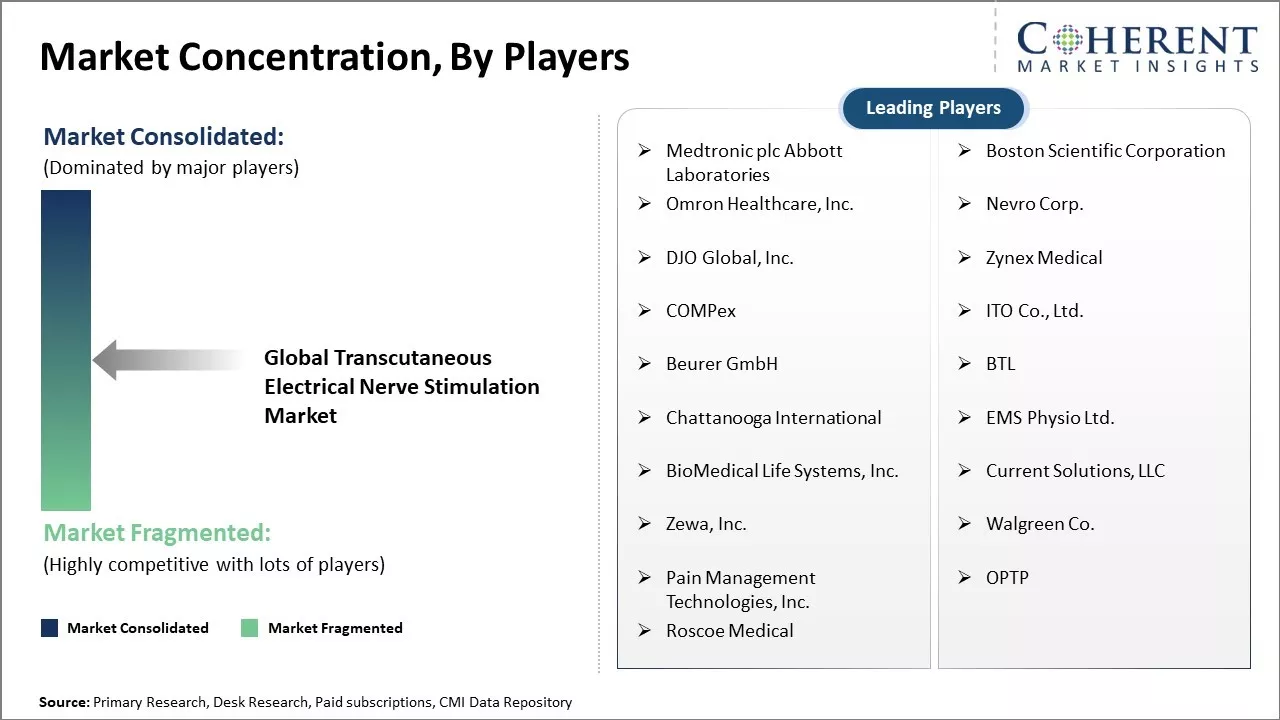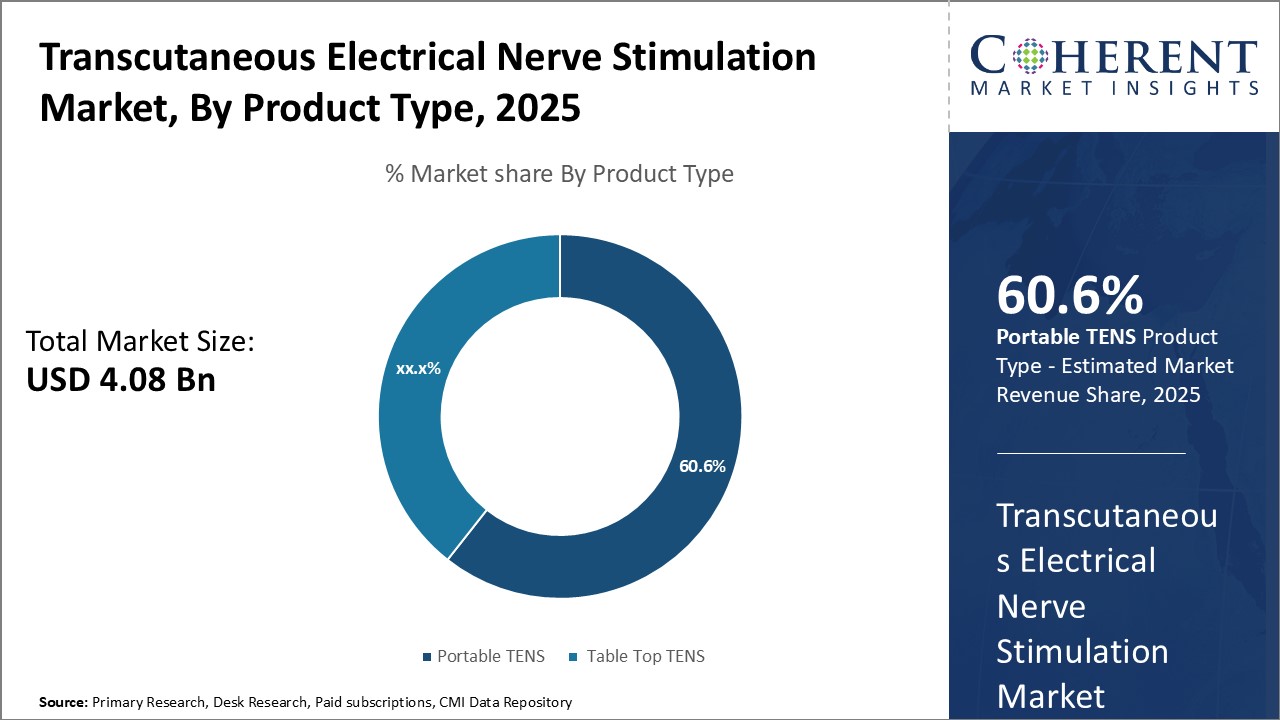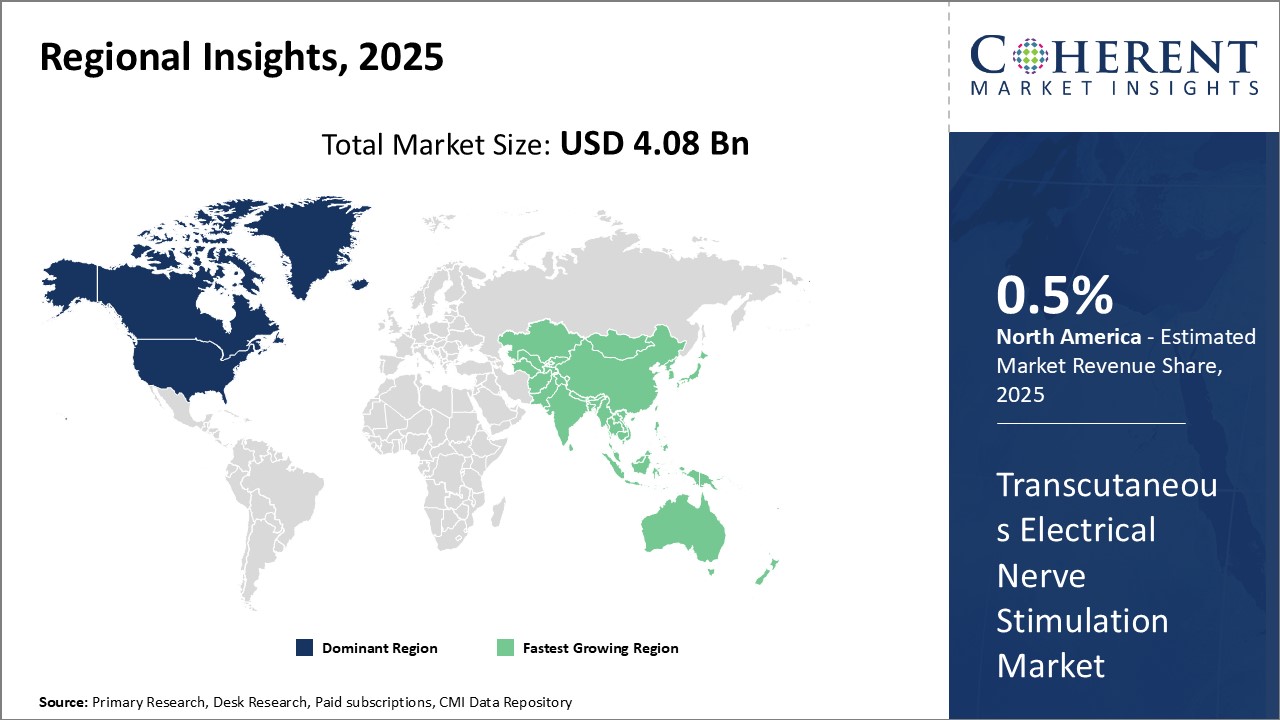Transcutaneous Electrical Nerve Stimulation Market Size and Trends
The global Transcutaneous Electrical Nerve Stimulation Market is estimated to be valued at USD 4.08 Bn in 2025 and is expected to reach USD 5.52 Bn by 2032, growing at a compound annual growth rate (CAGR) of 4.4% from 2025 to 2032.

Discover market dynamics shaping the industry: Download Free Sample
The transcutaneous electrical nerve stimulation market is expected to witness significant growth over the forecast period. The rising geriatric population suffering from osteoarthritis and chronic pain disorders is expected to drive the demand for TENS devices. Additionally, the increasing preference for non-invasive pain treatment modalities as compared to opioid medications is also augmenting the market growth. Moreover, ongoing technological advancements resulting in compact and smaller TENS devices with enhanced features is further fueling the demand. Various new product launches by the top players with improved usability and efficacy is also boosting the transcutaneous electrical nerve stimulation industry. However, availability of alternative pain treatment options and poor reimbursement policies in some regions may hamper the market growth to some extent during the forecast years.
Rising prevalence of chronic pain
The global prevalence of chronic pain is steadily increasing over the years. According to some estimations, almost 20% of the global adult population suffers from chronic pain. Chronic pain conditions like back pain, arthritis, neuropathic pain, etc. have a significant impact on the quality of life as well as pose a huge economic burden. Transcutaneous electrical nerve stimulation (TENS) therapy has emerged as an effective non-invasive pain management technique for treating various types of chronic pain. TENS device delivers mild electrical signals to the body through electrodes placed on the skin. This masks the sensation of pain by stimulating the nerves under the skin and releasing endorphins which are the body's natural pain relievers. Compared to oral pain medications, TENS therapy does not have major side effects and risks of addiction or overdose. With the growing chronic pain population worldwide and limitations of conventional pain therapies, demand for TENS devices is increasing significantly. This favorable shift towards non-invasive pain management solutions is a major driver propelling the growth of the global TENS market. For instance, the May 2023 article from the National Institutes of Health highlighted the following key points: a high incidence of new chronic pain cases, significant progression from non-chronic to chronic pain, persistent chronic pain rates, and a minority of individuals achieving pain-free status after experiencing chronic pain. These findings underscore the importance of early intervention and ongoing management strategies in addressing chronic pain effectively.
Market Concentration and Competitive Landscape

Get actionable strategies to beat competition: Download Free Sample
Increasing preference for drug-free pain management solutions
The rising concerns regarding over-prescription and overuse of opioids and other pain medications have boosted interest in non-pharmacological pain management therapies. Various studies have shown a strong link between long-term use of opioids and risk of addiction, overdose, and death. Due to these risks, patients are showing heightened interest in exploring alternative treatment options for chronic pain that do not involve regular intake of pain medications. At the same time, certain population groups like pregnant women and elderly prefer avoiding medications during pregnancy and due to higher risk of side effects respectively. Transcutaneous electrical nerve stimulation provides a simple, drug-free and needle-free solution for managing both acute and chronic pain. TENS devices do not have major safety issues and risk of dependence like oral pain medications. This has increased their acceptability as first-line treatments for many painful conditions. The preference for safer pain management solutions without pharmaceutical dependencies is a key factor driving more patients and healthcare providers to consider TENS therapy. For instance, in September 2020, NeuroMetrix Inc., a provider of neurostimulation medical devices, launched the Quell App for Apple Watch users. This wearable TENS device is designed for knee, foot, and leg pain and is available over the counter (OTC).
Key Takeaways from Analyst:
The global transcutaneous electrical nerve stimulation market is poised to witness steady growth over the next decade. Rising geriatric population suffering from chronic pain conditions like arthritis will drive the demand for pain relief TENS devices. However, availability of alternative treatment options could limit market expansion to some extent. Additionally, lack of insurance coverage for TENS devices in many countries restrains their adoption rate.
North America currently dominates the market owing to growing obesity and subsequent chronic pain cases. Advanced healthcare infrastructure and reimbursement have further supported market growth in the region. Asia Pacific promises high growth potential led by rapidly developing economies of China and India. Increasing expenditure on healthcare and growing awareness about pain management techniques are key growth determinants in the region.
Lower costs and favorable government policies are encouraging transcutaneous electrical nerve stimulation device manufacturers to tap into opportunities in Asia Pacific and Latin America. Portable and wireless TENS devices with simplified designs and easy-to-use features will expand the consumer base. Additionally, frequent product launches with multi-channel options and customized treatments are allowing manufacturers to strengthen their positions. Cloud-based reporting and remote monitoring capabilities in newer devices will boost their adoption in the coming years.
Market Challenges: Preference for alternative therapies
The preference for alternative therapies among people is a major factor restraining the growth of the global transcutaneous electrical nerve stimulation market. Many people experiencing pain prefer to try alternative therapies like acupuncture, yoga, meditation, or herbal medicines before adopting methods like TENS. Alternative therapies are generally considered more natural and have fewer side effects than options involving medical devices or pharmaceutical drugs. This perception has led many to first exhaust alternative options to pain relief through lifestyle and dietary changes or complementary practices. Only when alternative therapies provide inadequate relief do people consider methods like TENS involving a device. Furthermore, the growth of the alternative therapy industry has made these options much more accessible and acceptable worldwide. For example, practices like acupuncture or yoga have grown enormously in popularity in western nations over the past two decades. The National Health Interview Survey conducted by the Centers for Disease Control and Prevention found the share of U.S. adults using yoga, chiropractic/osteopathic manipulation, and meditation had doubled between 2002 and 2012.
Market Opportunities: Emerging economies offer attractive opportunities for investment.
Emerging economies present significant opportunities for growth in the global transcutaneous electrical nerve stimulation market. Many developing nations are undergoing rapid digitalization and have a young population receptive to new technologies. These nations are also investing heavily in expanding access to healthcare through both public and private investments. A key factor driving the market is the increasing availability of affordable TENS devices in emerging countries. Various device manufacturers and medical technology companies have launched low-cost versions of TENS machines tailored for consumers in price-sensitive markets. This has made TENS therapy an accessible option for pain relief even in rural and underserved areas. According to the Indian Brand Equity Foundation, the Indian medical devices market is projected to reach US$50 billion by 2025, boosted by government initiatives for inclusive healthcare and growth in domestic manufacturing. Indian companies are producing affordable TENS machines and electrodes, tapping into vast unmet needs within the country.

Discover high revenue pocket segments and roadmap to it: Download Free Sample
Insights By Product Type - Portability drives the growth of portable TENS devices
In terms of product type, portable TENS is expected to contribute the highest share of the market with 60.10 % in 2025 owing to the convenience and flexibility they offer over table top devices. Portable TENS units allow for pain relief to be administered anywhere and at any time. Their compact, lightweight design makes them highly portable and easy to operate with one hand. This has made them especially popular among active individuals looking to self-administer pain relief while on the go or during exercise. The lack of wires and electrodes tethering the user to an electrical outlet also provides more freedom of movement compared to bulkier table top units. Manufacturers have further enhanced portability through long-lasting battery life and additional features like memory pre-sets for easy one-touch therapy sessions. The growing trend of on-demand, mobile healthcare has also boosted the demand for handheld TENS products that can be carried and used discreetly anywhere.
Insights By Application Type- Chronic pain indications drive use in long-term pain management
In terms of application type, chronic pain is expected to contribute the highest share of the market with 50.11 % in 2025 as TENS devices effectively provide relief for long-term, ongoing pain conditions. TENS therapy is widely used and recommended for chronic pain related to osteoarthritis, lower back pain, nerve pain, fibromyalgia, and other musculoskeletal disorders that often require repeated, ongoing treatment over months or years. Its non-invasive, drug-free approach makes it a preferred choice for managing chronic pain without the side effects of pain medications. The ability to self-administer pain relief at home also adds convenience compared to visiting a clinic regularly for other therapies. Manufacturers have received FDA clearance for many TENS units to be used in long-term pain management, reassuring patients and physicians of their safety for extended, repeated use cases. This has solidified TENS as a mainstream treatment modality for maintaining quality of life with numerous chronic pain types.
Insights By End-user Type- Hospital dominance is driven by reimbursements and clinical expertise
In terms of end-user type, hospitals is expected to contribute the highest share of the market with 30.61% in 2025 since they can leverage public and private reimbursements as well as clinical expertise to widely adopt TENS technology. Many government and private insurance plans provide at least partial coverage for TENS therapy administered in hospital outpatient or physical therapy settings. This enables more affordable access for patients dealing with conditions like failed back surgery syndrome or post-surgical pain. Hospitals also benefit from equipment purchases being eligible for tax deductions or other financial incentives. Additionally, the presence of pain medicine physicians and dedicated pain clinics within hospitals allows for specialized evaluation, custom fitting, and oversight that reassures initial and ongoing users. Trained hospital staff can also properly introduce TENS and address any technique or safety questions. This clinical experience and funding support has made hospitals the leading end-users for purchasing volume.
Regional Insights

Need a Different Region or Segment? Download Free Sample
North America has dominated the global transcutaneous electrical nerve stimulation market for several years. The region is home to some of the largest medical device companies such as Medtronic, Boston Scientific and Abbott, which have established a strong sales network and brand presence. Additionally, rising healthcare expenditure, growing elderly population suffering from chronic pain and awareness of neurostimulation therapies have fueled market growth. The presence of advanced healthcare infrastructure and availability of reimbursement for TENS devices boost adoption in the U.S.
However, the Asia Pacific region is emerging as the fastest growing regional market attributable to improving access to modern healthcare facilities even in remote areas. Countries like China and India represent huge patient pools suffering from pain due to growing incidence of orthopedic disorders, cancer and neurological conditions. This has prompted local manufacturers to indigenously develop low-cost TENS devices. Their pricing nearly half of international brands has helped penetrate rural regions. Favorable government initiatives supporting medical device exports has helped Chinese companies establish foothold in other Asian and African markets.
Market Report Scope
Transcutaneous Electrical Nerve Stimulation Market Report Coverage
| Report Coverage | Details | ||
|---|---|---|---|
| Base Year: | 2024 | Market Size in 2025: | USD 4.08 Bn |
| Historical Data for: | 2020 To 2024 | Forecast Period: | 2025 To 2032 |
| Forecast Period 2025 to 2032 CAGR: | 4.4% | 2032 Value Projection: | USD 5.52 Bn |
| Geographies covered: |
|
||
| Segments covered: |
|
||
| Companies covered: |
Medtronic plc Abbott Laboratories, Boston Scientific Corporation, Omron Healthcare, Inc., Nevro Corp., DJO Global, Inc., Zynex Medical, COMPex, ITO Co., Ltd., Beurer GmbH, BTL, Chattanooga International, EMS Physio Ltd., BioMedical Life Systems, Inc., Current Solutions, LLC, Zewa, Inc., Walgreen Co., Pain Management Technologies, Inc., OPTP, and Roscoe Medical |
||
| Growth Drivers: |
|
||
| Restraints & Challenges: |
|
||
Uncover macros and micros vetted on 75+ parameters: Get instant access to report
Transcutaneous Electrical Nerve Stimulation Industry News
- In January 2022, TensCare, a manufacturer and distributor of TENS machines, participated in the ABHI UK Pavilion at Arab Health 2022. It showcased its newest products, featuring advanced transcutaneous electrical nerve stimulation (TENS) technology. TENS is widely recognized for drug-free pain relief, beneficial in treating chronic conditions like diabetic neuropathy, back pain, sciatica, osteoarthritis, and acute childbirth pain. Additionally, TensCare presented its range of electrotherapy devices designed to enhance muscle toning and address issues such as bladder weakness and incontinence.
- In April 2020, Synapse Biomedical obtained Emergency Use Authorization (EUA) from the U.S. FDA for its TransAeris, a diaphragm stimulator aiding COVID-19 patients in transitioning from mechanical ventilation. As global COVID-19 recoveries increase, there is anticipated growth in the demand for TransAeris and similar devices in homecare settings, likely boosting market expansion in the foreseeable future.
- In April 2020, OMRON Healthcare, Inc., a global company in personal heart health and wellness technology, introduced Focus TENS Therapy for Knee. This new addition to its pain management products utilize transcutaneous electrical nerve stimulation (TENS) technology in a sleek, wearable device. It offers wireless capabilities and customizable relief for chronic, arthritic, and acute pain related to exercise strain or daily activities.
*Definition: The global transcutaneous electrical nerve stimulation market consists of medical devices that use low-voltage electrical currents to stimulate the peripheral nerves through the surface of skin instead of inserting needles into the body. These TENS devices are non-invasive and used as a pain relief treatment option for various chronic and acute pain conditions like lower back pain, arthritis pain, neuropathic pain and more. The global TENS market provides physicians and patients a drug-free alternative for pain management therapy.
Market Segmentation
- Product Type Insights (Revenue, USD Bn, 2020 - 2032)
- Portable TENS
- Table Top TENS
- Application Type Insights (Revenue, USD Bn, 2020 - 2032)
- Chronic Pain
- Acute Pain
- End-user Type Insights (Revenue, USD Bn, 2020 - 2032)
- Hospitals
- Physiotherapy Clinics
- Rehabilitation Centers
- Home care
- Others
- Regional Insights (Revenue, USD Bn, 2020 - 2032)
- North America
- U.S.
- Canada
- Latin America
- Brazil
- Argentina
- Mexico
- Rest of Latin America
- Europe
- Germany
- U.K.
- Spain
- France
- Italy
- Russia
- Rest of Europe
- Asia Pacific
- China
- India
- Japan
- Australia
- South Korea
- ASEAN
- Rest of Asia Pacific
- Middle East
- GCC Countries
- Israel
- Rest of Middle East
- Africa
- South Africa
- North Africa
- Central Africa
- North America
- Key Players Insights
- Medtronic plc Abbott Laboratories
- Boston Scientific Corporation
- Omron Healthcare, Inc.
- Nevro Corp.
- DJO Global, Inc.
- Zynex Medical
- COMPex
- ITO Co., Ltd.
- Beurer GmbH
- BTL
- Chattanooga International
- EMS Physio Ltd.
- BioMedical Life Systems, Inc.
- Current Solutions, LLC
- Zewa, Inc.
- Walgreen Co.
- Pain Management Technologies, Inc.
- OPTP
- Roscoe Medical
Share
Share
About Author
Manisha Vibhute is a consultant with over 5 years of experience in market research and consulting. With a strong understanding of market dynamics, Manisha assists clients in developing effective market access strategies. She helps medical device companies navigate pricing, reimbursement, and regulatory pathways to ensure successful product launches.
Missing comfort of reading report in your local language? Find your preferred language :
Transform your Strategy with Exclusive Trending Reports :
Frequently Asked Questions
EXISTING CLIENTELE
Joining thousands of companies around the world committed to making the Excellent Business Solutions.
View All Our Clients
